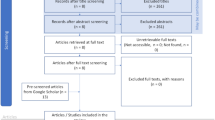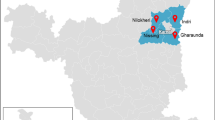Abstract
In Pakistan, due to the asymmetries in farmers’ information access, many ICT-based initiatives have been taken as an alternative to conventional agricultural extension approaches. Recently telecommunication sector of Pakistan has launched farm advisory services for reaching farmers’ information needs. This paper analyzed the telecom sector’s mobile-based farm advisory services (mFAS) by exploring, provided content, farmers’ use, experiences, and its associated factors using the Likert scale and bivariate Probit regression. The study employed a multistage random sampling technique to collect data from the smallholders of Muzaffargarh district of Pakistan. Findings revealed that 70% of the respondents were subscribed to mFAS. Results further indicated a vast gap between the farmers’ access and practical use of provided information in which weather forecast reported the most, while market updates reported the least utilization gap. Similarly, reduced transportation cost was ranked the most, while avoiding potential crop damages was ranked as the least perceived indicators of effectiveness. The study further reported one-way communication mode and farmers’ limited skills of mobile phone use as the major constraint in the use of the services. The results of the Probit model found a significant positive relation of farmers’ education, credit utilization, and educated family members, while a significant negative relation of farmers’ age with the use of mFAS. Based on findings, this study highlights the need for an interactive communication mode, context-specific advisory services, and farmers’ training and education for the successful utilization of these services.

Source: Authors’ own illustration


Similar content being viewed by others
References
Vanlauwe, B., Coyne, D., Gockowski, J., Hauser, S., Huising, J., Masso, C., et al. (2014). Sustainable intensification and the African smallholder farmer. Current Opinion in Environmental Sustainability, 8, 15–22.
Emeana, E., Trenchard, L., & Dehnen-Schmutz, K. (2020). The Revolution of mobile phone-enabled services for agricultural development (m-Agri Services) in Africa: The challenges for sustainability. Sustainability, 12, 485. https://doi.org/10.3390/su12020485.
Iqbal, M., Imam, M. F., Amir, R., Khan, N. A., Qayyum, M., & Malik, M. (2016). Assessing training needs of farmers in Pakistan: a case of farmer field schools (fruit and vegetable project) in Tehsil Rawalpindi. Journal of Global Innovation in Agriculture and Social Scieces, 4(4), 204–206. https://doi.org/10.22194/JGIASS/4.4.763.
Freeman, K., & Qin, H. (2020). The role of information and interaction processes in the adoption of agriculture inputs in Uganda. Agronomy, 10(2), 202.
Cox, A. J., & Sseguya, H. (2015). ICT supported extension services in conservation agriculture information access for small holder farmers in Laikipia County, Kenya. In 2015 IEEE international symposium on technology and society. https://doi.org/10.1109/istas.2015.7439408.
Baloch, M. A., & Thapa, G. B. (2017). Review of the agricultural extension modes and services with the focus to Balochistan, Pakistan. Journal of the Saudi Society of Agricultural Sciences, 18, 188–194.
Khan, N. A., Qijie, G., Ali, S., Shahbaz, B., & Shah, A. A. (2019). Farmers’ use of mobile phone for accessing agricultural information in Pakistan: a case of Punjab province. Ciência Rural. https://doi.org/10.1590/0103-8478cr20181016.
Elahi, E., Abid, M., Zhang, L., ul Haq, S., & Sahito, J. G. M. (2018). Agricultural advisory and financial services; farm level access, outreach and impact in a mixed cropping district of Punjab, Pakistan. Land Use Policy, 71, 249–260.
Abid, M., Scheffran, J., Schneider, U. A., & Ashfaq, M. (2015). Farmers’ perceptions of and adaptation strategies to climate change and their determinants: The case of Punjab province, Pakistan. Earth System Dynamics, 6(1), 225–243. https://doi.org/10.5194/esd-6-225-2015.
Rehman, A., Jingdong, L., Shahzad, B., Chandio, A. A., Hussain, I., Nabi, G., et al. (2015). Economic perspectives of major field crops of Pakistan: An empirical study. Pacific Science Review B: Humanities and Social Sciences, 1(3), 145–158. https://doi.org/10.1016/j.psrb.2016.09.002.
GoP. (2018). Government of Pakistan. Pakistan Economic Survey 2017–18. Economic advisor’s wing, Finance Division, Islamabad, Pakistan.
Khan, N. A., Gao, Q., Iqbal, M. A., & Abid, M. (2020). Modeling food growers’ perceptions and behavior towards environmental changes and its induced risks: evidence from Pakistan. Environmental Science and Pollution Research International, 27(16), 20292–20308. https://doi.org/10.1007/s11356-020-08341-y.
Zhen, Y., Z-h, H. U. A. N. G., Yu, W., & J-h, Z. H. O. U. (2019). Are social embeddedness associated with food risk perception under media coverage? Journal of Integrative Agriculture, 18(8), 1804–1819.
Hudson, H. E., Leclair, M., Pelletier, B., & Sullivan, B. (2017). Using radio and interactive ICTs to improve food security among smallholder farmers in Sub-Saharan Africa. Telecommunications Policy, 41(7–8), 670–684. https://doi.org/10.1016/j.telpol.2017.05.010.
Kassem, H. S., Shabana, R. M., Ghoneim, Y. A., & Alotaibi, B. M. (2019). Farmers’ perception of the quality of mobile-based extension services in Egypt: A comparison between public and private provision. Information Development, 0266666919832649.
Mwalupaso, G., Tian, X., Matafwali, E., Mwamba, M., Alavo, J.-P., Mamo, A., et al. (2019). Understanding the purpose and potential popularity of mobile phone use in Zambia’s Maize production. Journal of Agricultural Science. https://doi.org/10.5539/jas.v11n6p32.
Larochelle, C., Alwang, J., Travis, E., Barrera, V. H., & Dominguez Andrade, J. M. (2019). Did you really get the message? Using text reminders to stimulate adoption of agricultural technologies. The Journal of Development Studies, 55(4), 548–564. https://doi.org/10.1080/00220388.2017.1393522.
George, T., Bagazonzya, H., Ballantyne, P., Belden, C., Birner, R., Del Castello, R., et al. (2011). ICT in agriculture: Connecting smallholders to knowledge, networks, and institutions. Washington, DC: World Bank.
Ogutu, S. O., Okello, J. J., & Otieno, D. J. (2014). Impact of information and communication technology-based market information services on smallholder farm input use and productivity: The case of Kenya. In Paper presented at the international conference of the african association of agricultural economists september 22–25, 2013, Hammamet, Tunisia.
Ali, J., & Kumar, S. (2011). Information and communication technologies (ICTs) and farmers’ decision-making across the agricultural supply chain. International Journal of Information Management, 31, 149–159. https://doi.org/10.1016/j.ijinfomgt.2010.07.008.
Tadesse, G., & Bahiigwa, G. (2015). Mobile phones and farmers’ marketing decisions in Ethiopia. World Development, 68, 296–307. https://doi.org/10.1016/j.worlddev.2014.12.010.
Patra, J., Singh, D., & Pati, J. (2016). Kisan mobile advisory service-an effective ICT tool for technology dissemination. International Journal of Humanities and Social Science Invention, 5(6), 68–72.
Zhang, Y., Wang, L., & Duan, Y. (2016). Agricultural information dissemination using ICTs: A review and analysis of information dissemination models in China. Information Processing in Agriculture. https://doi.org/10.1016/j.inpa.2015.11.002.
Mokotjo, W., & Kalusopa, T. (2010). Evaluation of the agricultural information service (AIS) in Lesotho. International Journal of Information Management, 30(4), 350–356. https://doi.org/10.1016/j.ijinfomgt.2010.01.005.
Gia Hung, H. (2020). Adoption of Mobile phone for marketing of cereals by smallholder farmers in Quang Dien district of Vietnam. Journal of Agricultural Extension, 24(1), 106–117. https://doi.org/10.4314/jae.v24i1.11.
Koyu, B., Singh, R. J., Kalai, K., Laitonjam, N., & Meena, N. K. (2018). e-Readiness of farmers in agricultural extension system: A case of Ri-Bhoi district, Meghalaya. India. Plant Archives, 18(1), 117–120.
Moyo, R., & Salawu, A. (2019). A survey of communication media preferred by smallholder farmers in the Gweru District of Zimbabwe. Journal of Rural Studies, 66, 112–118.
Rahman, S., Haque, M., & Afrad, M. (2020). Utility of mobile phone usage in agricultural information dissemination in Bangladesh. 3, 154–170. https://doi.org/10.36349/EASJALS.2020.v03i06.020.
Fitchett, J. M., & Ebhuoma, E. (2018). Phenological cues intrinsic in indigenous knowledge systems for forecasting seasonal climate in the Delta State of Nigeria. International Journal of Biometeorology, 62(6), 1115–1119. https://doi.org/10.1007/s00484-017-1495-x.
Wright, D., Hammond, N., Thomas, G., MacLeod, B., & Abbott, L. K. (2018). The provision of pest and disease information using Information Communication Tools (ICT); An Australian example. Crop protection, 103, 20–29.
Afzal, A., Al-Subaiee, F., & Mirza, A. (2016). The attitudes of agricultural extension workers towards the use of E-extension for ensuring sustainability in the Kingdom of Saudi Arabia. Sustainability, 8, 980. https://doi.org/10.3390/su8100980.
Maqsood, L. (2015). Use of mobile technology among rural women in Pakistan for agricultural extension information. Michigan State University. Telecommunication, Information Studies and Media.
Shahbaz, B., Ata, S., & Ali, S. (2013). Agricultural development through ICTs: Cyber extension in Punjab, Pakistan. In Paper presented at the SDPI’s sixteenth sustainable development conference, 10–12 December 2013.
Punjab Go. (2017). Electronic Media. Directorate of Agriculture (Information) Punjab.
Khan, G. A., Muhammad, S., Chaudhry, K. M., & Khan, M. A. (2010). Present status and future preferences of electronic media as agricultural information sources by the farmers. Pakistan Journal of Agricultural Sciences, 47(2), 166–172.
Khan, N. A., Qijie, G., Sertse, S. F., Nabi, M. N., & Khan, P. (2019). Farmers’ use of mobile phone-based farm advisory services in Punjab, Pakistan. Information Development, 36(3), 026666691986412. https://doi.org/10.1177/0266666919864126.
PTA. (2018). Pakistan Telecommunication Authority. Telecom Indicators. Annual Report 2017-18. PTA Headquarters, F-5/1, Islamabad.
Jazz, (2018). Bakhabar Kissan. Agriculture Value Added Services.
GSMA. (2017). Khushaal Zamindar: a mobile agriculture service by Telenor Pakistan. GSMA HEAD OFFICE Floor 2 The Walbrook Building 25 Walbrook London EC4N 8AF United Kingdom https://www.gsma.com/mobilefordevelopment/magri/creating-scalable-mobile-solutions/.
GoP. (2019). Government of Punjab. Statistical Pocket book of the Punjab. Bureau of Statistics Lahore.
Nawaz, S., & Iqbal, N. (2016). Education poverty in Pakistan: A spatial analysis at district level. Indian Journal of Human Development, 10(2), 270–287.
BOS. (2017). Province wise rsults of population census. Pakistan Population Census 2017. http://www.pbs.gov.pk/sites/default/files/PAKISTAN%20TEHSIL%20WISE%20FOR%20WEB%20CENSUS_2017.pdf.
GoP. (1998). Government of Pakistan: Pakistan Mouza statistics. Statistics Division Agricultural Census Organization, Islamabad, Pakistan.
Fernihough, A. (2011). Simple logit and probit marginal effects in R. UCD Centre for Economic Research Working Paper Series; WP11/22. University College Dublin. School of Economics.
Peng, C.-Y. J., Lee, K. L., & Ingersoll, G. M. (2002). An introduction to logistic regression analysis and reporting. The journal of educational research, 96(1), 3–14.
Stephenson, B., Cook, D., Dixon, P., Duckworth, W., Kaiser, M., Koehler, K., & Meeker, W. (2008). Binary response and logistic regression analysis. https://citeseerx.ist.psu.edu/viewdoc/download?doi=10.1.1.142.6636&rep=rep1&type=pdf.
Kassem, H. S., Aldosari, F. O., Baig, M. B., Muneer, S., & Elmajem, A. N. (2018). Researchers’ and extension workers’ perspectives on agricultural research-extension linkages in the Kingdom of Saudi Arabia. Journal of Animal & Plant Sciences, 28(5), 1516–1522.
Kumari, S., Sethi, N., Jodha, R., & Mehala, V. (2017). Implications and limitations in mobile based advisory services through KVKs in Haryana. Annals of Biology (Hissar), 33(2), 316–318.
Faruque As, S., Huang, Z. H., & Karimanzira, T. T. P. (2018). Investigating key factors influencing farming decisions based on soil testing and fertilizer recommendation facilities (STFRF) a case study on rural Bangladesh. Sustainability, 10(11), 24. https://doi.org/10.3390/su10114331.
Masuka, B., Chipomho, J., Mapope, N., Mupeti, S., Tatsvarei, S., Ngezimana, W., et al. (2016). Mobile phone use by small-scale farmers: A potential to transform production and marketing in Zimbabwe. South African Journal of Agricultural Extension, 44(2), 121–135. https://doi.org/10.17159/2413-3221/2016/v44n2a406.
Rajwana, I. A., Razzaq, K., Hussain, S. B., Amin, M., & Malik, A. U. (2017). Strawberry cultivation in southern Punjab Pakistan. Acta Horticulturae, 1156, 909–914.
Acknowledgements
We are thankful to the United States Pakistan Center for Advanced Studies in Agriculture and Food Security (USPCAS-AFS), University of Agriculture Faisalabad Pakistan, and the College of Humanities and Development Studies (COHD), China Agricultural University Beijing China for the support in completing this research. We further extend our gratitude to the District Agriculture Department Muzaffargarh-Pakistan and Star Farms (Pvt.) for their cooperation during the field survey.
Author information
Authors and Affiliations
Corresponding author
Ethics declarations
Conflict of interest
The authors declare they have no conflict of interest.
Additional information
Publisher's Note
Springer Nature remains neutral with regard to jurisdictional claims in published maps and institutional affiliations.
Rights and permissions
About this article
Cite this article
Khan, N.A., Gao, Q., Ali, S. et al. Analyzing ICT-enabled agricultural advisory services in Pakistan: evidence from a marginalized region of Punjab province. Electron Commer Res 22, 1107–1129 (2022). https://doi.org/10.1007/s10660-020-09442-z
Accepted:
Published:
Issue Date:
DOI: https://doi.org/10.1007/s10660-020-09442-z




